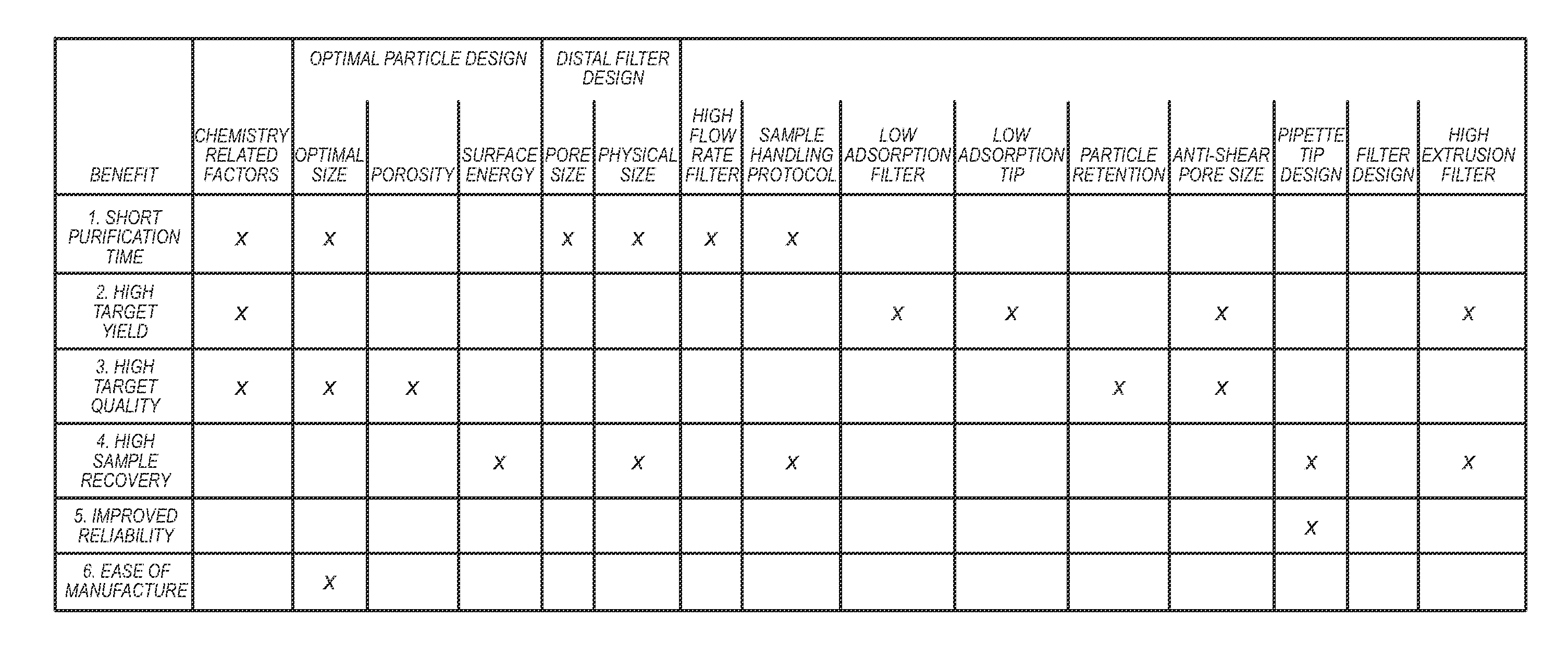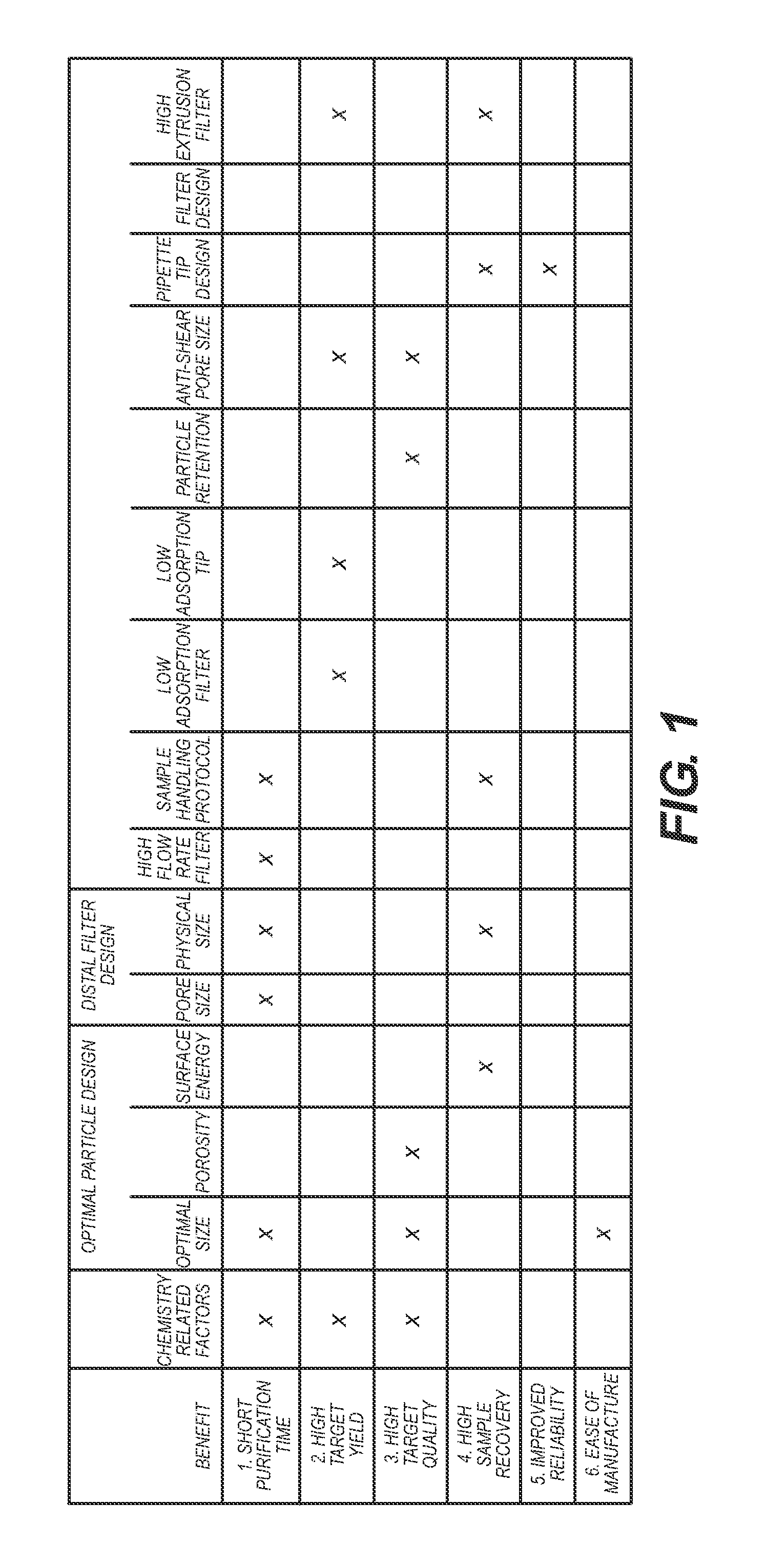System and methods for purifying biological materials
a biological material and system technology, applied in the field of systems and methods for purifying fluids, can solve the problems of inability to achieve the purification effect of target nucleic acids, etc., to achieve the effect of reducing the potential for error
- Summary
- Abstract
- Description
- Claims
- Application Information
AI Technical Summary
Benefits of technology
Problems solved by technology
Method used
Image
Examples
example 1
6.1 Example 1
Preferred Embodiment of Fluid Sample Purification System
[0482]This example demonstrates a preferred embodiment of the fluid sample purification system. The system comprises a distal particle retainer that has effective particle retention, minimizes resistance to fluid flow, has consistent tip-to-tip flow resistance, has faster sample processing time, minimizes retention of sample fluid, has improved product manufacturability, has reduced product manufacturing cost, and has improved sample quality.
[0483]This example describes an improved pipette filter design that can be used in the fluid sample purification system. Specific features of the filter include very low fluid flow resistance, consistent fluid flow resistance, uniform pore size, low sample retention and low cost. Unlike prior art fluid sample purification systems, the embodiment of the fluid sample purification system with this filter design has features within the pipette tip, rather than a separate filter, to...
example 2
6.2 Example 2
Fluid Sample Purification System Comprising Pipette Tip with Mixing (Reaction) Chamber
[0501]This example describes an additional embodiment of the fluid sample purification system that comprises a pipette, tip that has a different fluid mixing (or reaction) chamber design than described above. The mixing (reaction) chamber has a low slenderness ratio, which design permits more effective interaction between the aspirated / dispensed sample and adsorption materials. FIG. 40b shows pipette tip A containing loosely packed particles (not shown but similar to FIG. 2) and distal particle retainer B designed with a mixing chamber C with low height L. (FIG. 40a shows a typical prior art pipette tip configuration.) There exists a transition region which transitions nozzle diameter d to internal pipette diameter D in a very short distance. Preferably, angle β is approximately thirty degrees so as to help ensure uniform transition of fluid flow from the pipette nozzle to the larger i...
example 3
6.3 Example 3
Fluid Sample Purification System Comprising Pipette Tip with Minimum Internal Air Volume
[0505]This example describes an additional embodiment of the fluid sample purification system that comprises a pipette tip with an internally positioned piston to minimize internal volume and create higher fluid sample aspiration and dispense pressures.
[0506]This embodiment of the fluid sample purification system comprises a pipette tip and a piston that provides minimum air volume within the pipette tip. Since the air contained within the pipette tip is a compressible fluid, the more air there is in the tip, the less the pressure or vacuum can be generated within the pipette tip for a given displacement of the pipettor's piston. Since the difference in pressure between the inside and outside of the pipette tip is the motive force for moving liquid into or out of the pipette tip, a smaller pressure or vacuum differences result in a lower sample flow rates. Sample flow rate is further...
PUM
| Property | Measurement | Unit |
|---|---|---|
| diameters | aaaaa | aaaaa |
| diameters | aaaaa | aaaaa |
| specific gravity | aaaaa | aaaaa |
Abstract
Description
Claims
Application Information
 Login to View More
Login to View More - R&D
- Intellectual Property
- Life Sciences
- Materials
- Tech Scout
- Unparalleled Data Quality
- Higher Quality Content
- 60% Fewer Hallucinations
Browse by: Latest US Patents, China's latest patents, Technical Efficacy Thesaurus, Application Domain, Technology Topic, Popular Technical Reports.
© 2025 PatSnap. All rights reserved.Legal|Privacy policy|Modern Slavery Act Transparency Statement|Sitemap|About US| Contact US: help@patsnap.com



